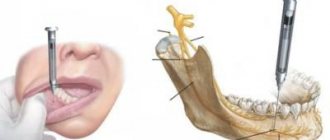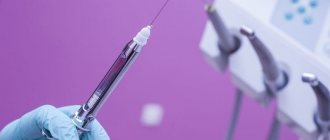More than thirty years have passed since the collapse of the Soviet Union, a lot has changed in medicine for the better, and people are still afraid to go to the dentist, remembering themselves or having heard from others how painful and unpleasant it is.
Anesthesia in Soviet dentistry was indeed a “weak link”, and many manipulations in the dentist’s chair were done without pain relief at all. However, now the situation has become much better, including thanks to the penetration of foreign drugs and technologies into our market.
The usual injection has been replaced by many different techniques. Of course, it’s still difficult to call a visit to the dentist pleasant, but it has definitely become much more comfortable.
Anesthesia
Modern anesthesia not only eliminates the patient’s physical pain during procedures, but also reduces his psycho-emotional stress - eliminates the fear of the doctor, which significantly increases the efficiency and quality of the specialist’s work.
Types of anesthesia in dentistry
Anesthesia in dentistry can be general or local. The first includes intravenous sedation, as well as general anesthesia. That is, the drugs do not act locally in the oral cavity, but throughout the entire body. Actually, this is ordinary general anesthesia, which is used everywhere in medicine - it’s just that certain types are used in dentistry. Local, as it is already becoming clear, includes the familiar “freezing”, which is administered by injection.
Separately, we can also distinguish xenon sedation or xenon therapy - the second name will be even more correct, since such anesthesia is used to prepare for local or general anesthesia. It allows you to reduce the level of anxiety and stress, saturates the body's cells with oxygen, due to which it has a general healing and even rejuvenating effect! It is not an independent type of pain relief, but is used in combination with other approaches.
Anesthetics
The most commonly used drugs in dentistry are Ultracaine, Ubistezin, Septanest and Orablock. The previously popular lidocaine and novocaine are no longer used - they are not as effective, the results come more slowly, and they are more toxic than the above solutions.
Complications of infiltration anesthesia
- Pain at the injection site is associated with a violation of the integrity of the tissue and goes away on its own within a couple of days
- Paresthesia due to injury to the nerve trunk with a needle. It is expressed by mild numbness or pain along the nerve fibers.
- Trismus is a muscle spasm due to a needle injury. Most often it goes away on its own within 3-4 days.
- Hematoma is essentially a bruise due to a violation of the integrity of blood vessels
- Edema - appears either due to a local allergic reaction or due to the characteristics of the body.
Xenon sedation or xenon therapy to prepare for main anesthesia
This is a separate type of anesthesia that can be used in combination with both local and general anesthesia (if necessary). Xenon is an inert gas that quickly begins to act and is just as quickly eliminated from the body. It has a relaxing effect: anxiety decreases, the patient relaxes. Moreover, during the operation he is fully conscious, can communicate with the doctor, and understands everything that is happening around him. The procedure can be interrupted if necessary if there is discomfort. At the same time, local anesthetics are used, since xenon itself does not have a pronounced analgesic effect.
Among the pleasant “bonuses” are saturation of cells with oxygen and restoration of metabolic processes. That is, this is not only a reduction in stress, but also a general improvement in the body’s health.
Drugs used
The success of conduction anesthesia depends not only on the technique used, but also on the drugs used. The following medications are used for this pain relief technique:
- Solutions of the Articaine series. They have a long lifespan and high efficiency. These include:
- Ultracaine.
- Septanest.
- Ubistezin.
- Lidocaine. It is a highly effective anesthetic and at the same time contains a minimal amount of toxic substances.
- Melivacaine. The duration of action of this drug is about 40 minutes. Melivacaine has no contraindications for use.
- Novocaine. This is perhaps the most frequently used remedy. It is characterized by low toxicity and rapid hydrolysis in the body.
General anesthesia in dentistry
With general anesthesia, the patient falls asleep for 1-2 hours or more, i.e. for the entire duration of treatment. The drug is administered intravenously, less often by inhalation. If possible, general anesthesia should still be avoided, since its effect on many organs is quite toxic. Even despite the fact that dentistry uses “lighter” drugs than during complex surgical operations. This is a fairly large load on the body, especially on the heart, nervous and cardiovascular systems.
Features of conduction anesthesia
This type of anesthesia involves the administration of an anesthetic through an injection into a place near the nerve that innervates (supplies nerves) the area of the oral cavity being operated on. Thus, sensitivity is blocked.
This type of anesthesia is considered preferable in dentistry because it has a small list of possible side effects. Strong conduction anesthesia relieves pain for 6-8 hours, while less aggressive anesthesia is used in dentistry.
Conduction anesthesia is in no way inferior to other methods of pain relief in dentistry. There are separate types of anesthesia for the upper and lower jaws, which take into account the location of the nerves in different areas.
To anesthetize the upper jaw, infraorbital anesthesia is most often used, which involves injecting an anesthetic under the eyeball. Tuberal anesthesia is also used, which is carried out by injecting a solution into the tubercle of the upper jaw.
The lower jaw is desensitized through the apodactyl and intraoral routes. With the apodactylic method, the doctor does not touch the patient, but inserts a needle into the area of the outermost molar. Intraoral anesthesia involves feeling the puncture site.
Apodactyl methods of conduction anesthesia
- Verlotsky's method. The needle is inserted into the fold that appears when the pterygomandibular ligament is stretched. The insertion is carried out in the middle between the wisdom teeth.
- Weisbrem's method. The procedure involves injecting an anesthetic into the mandibular eminence. This elevation is located on the inner surface of the branch, just above the bone tongue.
- Kadochnikov's method. This type of anesthesia is recommended in cases where it is difficult to open the mouth. The mucosa is pierced with a long needle over the large retromolar triangle, advanced to the torus, deepened by 3-3.5 cm and an anesthetic is injected.
- Gau-Gate method. The needle is inserted into the medial zone of the medial ligament through the fatty cord. The solution is released into the neck of the condylar process. This way, all three branches of the nerve of the lower jaw are anesthetized.
- Akinozi method. The needle is inserted with the jaws closed into the maxillary edge of the gum. The anesthetic must enter the tissue of the arch between the maxillary tubercle and the ramus of the jaw. Slow introduction of the solution is required. Pain relief occurs due to diffusion (the main branches of the nerve are located very close to this area).
The lower jaw can be numbed externally. It is strictly forbidden to use methods of anesthesia of the upper jaw on the lower jaw and vice versa. When developing these methods, the peculiarities of the structure of each jaw and nerve bundles were taken into account.
Extraoral methods of conduction anesthesia
- Submandibular. Inserting a needle under the lower edge of the lower jaw. The mandibular nerves are anesthetized.
- Podzykulova. You can insert the needle in front of the wheel (under the zygomatic arch), at the level of the middle of the trago-orbital line, or in front of the articular tubercle under the zygomatic arch. This numbs the entire mandibular nerve near the foramen ovale.
- Postmaxillary. The needle is inserted a centimeter below the mastoid process near the posterior edge of the lower jaw. The disadvantage of this method is the need to pierce the parotid gland. Damage to a large vessel is also possible.
- Anteriormaxillary. The doctor inserts the needle into the medial surface of the branch, moves it to the corner of the mouth and deepens it by 1.5 cm.
Conduction anesthesia makes it possible to combine it with general or spinal anesthesia, when not only anesthesia is required, but also muscle relaxation.
Intravenous sedation
Intravenous sedation does not have such pronounced negative consequences for the body. Softer and gentler drugs are used here. Sedation puts a person into a half-asleep state - the patient can respond to the doctor’s commands, communicate and understand him. At the same time, the person is completely relaxed and may even fall asleep for several hours. Thus, intravenous sedation is a more gentle and safe type of pain relief.
This is interesting! The word “sedation” itself means “calming.” It can be carried out either by inhalation (nitrous oxide or safer and more effective xenon is used for this), as well as intravenously with the selection of drugs strictly individually.
We treat without pain and discomfort!
Intravenous sedation
Safe and pain-free Treatment in your sleep Quick recovery from RUB 8,000. from 8,000 rub.
Xenon sedation
Relaxation before treatment No stress on the body Recovery in 2-3 minutes from RUB 5,000. from 5,000 rub.
With us you will stop being afraid of dentists! Individual selection of drugs, the most modern equipment and certified doctors who professionally work with all types of anesthesia.
Enroll now
Modern drugs for anesthesia
The choice of anesthetic depends on the patient's individual treatment plan and the method of anesthesia. For local topical anesthesia, gels, ointments and sprays based on lidocaine, dicaine, bumecaine, and benzocaine are currently used. For example, diplen - LH, topex gel, disilane, diseptin, xylonor.
For injection anesthesia, drugs such as procaine, lidocaine, mepivacaine, ultracaine, ubistezin, trimecaine, articaine, chirocaine, bipuvacaine are used. Inhalational sedation uses a mixture of nitrous oxide and oxygen. If you are afraid of visiting the dentist, you can take tranquilizers orally in the form of tablets, for example, diazepam, oxazepam, hydroxyzine, hexobarbital, as prescribed by the doctor.
What is local anesthesia?
Local anesthesia allows you to numb the specific area where the intervention is planned. The patient is conscious. And this is actually more than enough even for complex surgical operations.
For local administration of all types of anesthetics, special reusable syringes are used, which have a recess for inserting a carpule - this is a hermetically sealed ampoule with an anesthetic. Unlike disposable ones, carpule syringes have a thinner needle, which allows you to administer the drug slowly and thus eliminate pain. All syringes for reusable use must undergo antiseptic treatment and sterilization using modern ultrasonic and temperature sterilization equipment.
Anesthesia technique
A solution of novocaine is injected intradermally with a thin needle, warmed to body temperature. As a result, a “lemon peel” is formed at the site of the upcoming cut. Then a thicker needle is used to infiltrate the subcutaneous tissue and create a subcutaneous novocaine infiltrate. After this, the skin and subcutaneous tissue are dissected to the aponeurosis. Following this, the subgaleal space is tightly filled with novocaine solution, ending with the opening of the aponeurosis. If the intervention requires it, subsequent anesthesia of the peritoneum, mesentery or pleura, and the root of the lung is performed. In all cases, when performing infiltration anesthesia, the surgeon adheres to the rule - infiltration with an anesthetic must precede an incision with a scalpel. Novocaine blockades proposed by A.V. are based on a similar principle. Vishnevsky. It also uses tight filling of anatomical “cases” with anesthetic, which does not require direct application of the drug to the nerve trunks.
Infiltration anesthesia
Classic “freezing”, which is used in dentistry for almost any manipulation. The drug is injected under the mucosa, into the periosteum or directly into the bone. Depending on the procedure and the patient’s pain threshold, the required dosage is selected - for example, in case of acute pulpitis or complex tooth extraction, a higher concentration of the drug is used. If the patient is afraid of injections, topical anesthesia can additionally be used to numb the site of needle insertion, or xenon sedation.
When performing the procedure, the doctor must take into account the anatomy of the jaw system. For example, in the lower jaw the alveolar bone is denser, so anesthesia is less effective. In the upper jaw, when performing manipulations in the area of wisdom teeth, there is a risk of the needle touching one of the branches of the facial nerve, which is fraught with the development of neuralgia. The clinic’s doctors have the necessary qualifications, so even the most complex anesthesia is performed completely safely for the patient.
Tuberal anesthesia
Tuberal anesthesia is so named in connection with the injection site - the tubercles of the upper jaw, which are called tuber in Latin. The posterior alveolar nerves are located here, innervating the area of the alveolar ridge from the third to the first molar. This type of anesthesia is the most dangerous in terms of possible complications due to individual differences in the structure of this area and the location of nerves and blood vessels in it. There are intraoral and extraoral methods of administering tuberal anesthesia. It is believed that the intraoral method is more likely to cause injury, while the external method is safer and it is also easier to ensure adequate antiseptic treatment of the surface before injection.
Preparations for local anesthesia
The Smile-at-Once clinic uses modern anesthetics of the latest generation - effective, non-toxic and absolutely safe, even for pregnant women, the elderly or children. We do not use drugs based on novocaine or lidocaine due to toxicity and a high risk of allergic reactions. In addition, the articaine group of drugs, which are used today for local anesthesia, are 5-6 times more effective than lidocaine.
"Ultracaine" for all groups of patients
An original drug produced in France, which is used for both infiltration and conduction anesthesia.
It is safe, used even in the presence of allergic reactions, and is suitable for patients with heart disease and pregnant women. Its effectiveness is very high, while it is instantly eliminated from the body and does absolutely no harm. The main active ingredient is articaine, to which epinephrine is added to enhance the anesthetic and prolong its action. It provides local vasoconstriction, which significantly shortens the rehabilitation period after treatment. Depending on the concentration of epinephrine, there are three types of the drug - for different manipulations and categories of patients.
"Ultracaine-Forte" (concentration 1:100,000) is a drug with a high dose of epinephrine, used during surgical operations. "Ultracaine DS" with a low concentration (1:200,000) - is used for therapeutic treatment, including in patients with diseases of the cardiovascular system, high blood pressure, suitable for pregnant and lactating women. Ultracaine D does not contain epinephrine. The effect of the drug is short, but it can be used for allergic reactions, bronchial asthma, and pronounced cardiovascular pathologies.
"Ubistezin"
A cheaper, but no less high-quality analogue of Ultracain, produced by the German company 3M. It contains similar active ingredients: articaine hydrochloride and epinephrine. It has two forms of release, depending on the concentration of the latter (1:100,000 or 1:200,000). Use is allowed during breastfeeding and cardiovascular pathologies.
"Artikain"
An injection solution that consists directly of the main active ingredient - articaine. Inexpensive drug made in Russia. Used for infiltration or conduction anesthesia. Can be used in pure form or with the addition of epinephrine/glucose solution in a certain proportion. Not used for bronchial asthma and severe allergic reactions.
"Scandonest" for the elderly
The main active ingredient of this French-made drug is mepivacaine hydrochloride. It is not used during pregnancy and bronchial asthma, but use is allowed in patients with cardiovascular pathologies, since the drug does not contain epinephrine, adrenaline and preservatives. Suitable for older people, especially those with high blood pressure. It is one of the safest anesthetics for both infiltration and conduction anesthesia. Its disadvantage is its short duration of action, which requires repeated administration of the drug approximately every 30 minutes during long procedures.
"Orablock"
Another drug, the main active ingredients of which are articaine and epinephrine with varying concentrations of the latter, which affects the effect and duration of pain relief. Not used during pregnancy and pronounced cardiovascular pathologies.
"Naropin" for complex surgical operations
A long-acting anesthetic whose main active ingredient is ropivacaine hydrochloride. The duration of pain relief depends on the dosage. Very often, this drug is used for conduction anesthesia during complex surgical operations and the installation of a large number of implants. Among the contraindications is only individual intolerance to amide anesthetics.
GBUZ LO "Tosnenskaya Clinical Interdistrict Hospital"
Pain during dental procedures is perceived by patients as a lack of professionalism or a dismissive, inattentive attitude of the doctor. Therefore, anesthesia in dentistry is considered one of the most important stages of treatment, which largely determines its overall effectiveness, as well as its attractiveness to the patient.
Anesthesia in dentistry can be carried out using one of three methods:
- local anesthesia: application, infiltration and conduction;
- general anesthesia - temporary reversible loss of consciousness and all types of sensitivity;
- Potentiated analgesia (sedation) is a combination of local anesthesia with systemic administration of a narcotic analgesic or anxiolytic.
Local anesthesia
Local anesthesia means turning off pain sensitivity in a limited area by blocking the pain impulse through nerve endings. The drugs act exclusively in the injection area, the patient remains conscious and fully controls his actions. Most dental procedures can be performed under local anesthesia.
Depending on the method of introducing the drug into the tissue, methods of local anesthesia are divided into three types:
- application - the anesthetic is applied to the surface of the skin or mucous membrane and penetrates deeper due to diffusion;
- infiltration – the anesthetic drug permeates the tissue layer by layer;
- Conductive: central and peripheral - a depot of an anesthetic solution is created in the area of passage of a large nerve trunk.
Application anesthesia
The procedure is extremely simple: the anesthetic is applied directly to the skin or mucous membrane without violating its integrity. Preparations for local topical anesthesia in dentistry are produced in the form of gel ointments or concentrated solutions. In the first case, the surface to be numbed is lubricated; in the second, a cotton swab moistened with the drug is placed on it, or sprayed from a spray bottle.
The concentrated anesthetic, due to diffusion, penetrates 2-3 mm deep from the surface of the skin, blocking pain receptors of nerve endings. Pain relief occurs in approximately 3-5 minutes and lasts up to half an hour. The anesthetic substance is practically not absorbed into the blood, so this anesthesia technique is considered the safest.
Advantages of application dental anesthesia:
- painless during implementation;
- the effect occurs quickly;
- no resorptive effect is observed;
- minimal severity of side effects.
Flaws:
- shallow depth of anesthesia;
- short duration of action;
- impossibility of anesthesia of deeper tissues.
In what cases is topical anesthesia used?
- anesthesia of the injection site before injection anesthesia;
- removal of small neoplasms on a thin stalk located within the skin or mucous membrane;
- removal of dental plaque, periodontal applications;
- removal of baby teeth if the roots have already resolved and the crown is held on the mucous membrane;
- additional anesthesia of the pulp before its removal.
Infiltration anesthesia
This type of pain relief refers to injection techniques. The solution is injected deep into the soft tissues, saturating them. In this case, the nerve endings in the area of drug administration are switched off and all tissues soaked in the anesthetic are anesthetized.
Advantages of infiltration anesthesia:
- good control of the anesthesia zone;
- rapid onset of anesthesia;
- satisfactory duration and depth of action.
Flaws:
- a large amount of anesthetic may be required if the anesthesia area is large;
- deformation of soft tissues due to the injection of anesthetic and swelling in the injection area.
Infiltration techniques in dentistry include the following types of pain relief:
- intramucosal and submucosal – provides anesthesia of the mucous membrane and periosteum. In the upper jaw, where the bone tissue is more porous, with the use of modern anesthetics with high penetrating power, the pain sensitivity of several teeth or jawbone can be switched off;
- subperiosteal and plexual - usually carried out after the submucosa, since the injection itself is painful and disables the pain sensitivity of bone tissue and the dental nerve (the solution penetrates deep into the bone due to diffusion);
- intraligamentary - an anesthetic solution is injected into the periodontal ligament connecting the tooth root to the bone socket. The pain sensitivity of the pulp of one tooth is turned off. The main advantages of this technique are deep local anesthesia, absence of numbness of nearby tissues, bleeding of the pulp (the best conditions for endodontic canal treatment) and the use of extremely small amounts of anesthetic – 0.1-0.5 ml.
- intraseptal and intraosseous anesthesia in dentistry involves the introduction of an anesthetic solution into the porous spongy bone. On the outside, it is covered with a dense cortical plate, which is almost impossible to pierce with a regular needle. Therefore, for intraosseous anesthesia, special thick needles are used or the cortical plate is trepanned using a bur. With intraosseous administration of an anesthetic drug, deep anesthesia of the bone and all teeth in the area of drug administration is achieved, but this anesthesia technique is quite traumatic. Its use is justified during dental operations, in cases where the bone is already exposed during surgery.
Conduction anesthesia
In this case, a depot of an anesthetic drug is created in the area of passage of a large nerve trunk, while the conduction of pain sensitivity is switched off and the analgesic effect occurs in the entire zone of its innervation. Conduction anesthesia in dentistry involves the use of small volumes of anesthetics in relatively high concentrations.
Large blood and lymphatic vessels usually run parallel to the nerve trunks and in close proximity to them. When administering an anesthetic, the doctor is guided by the location of anatomical landmarks, but does not see the nerves and blood vessels directly. The possibility of accidental damage is not excluded, but with strict adherence to the technique, it is reduced to a minimum.
Depending on the size of the nerve trunk, central conduction anesthesia and peripheral anesthesia are distinguished. In the first case, it means disconnecting the main nerve trunks directly at the point of their exit from the cranial cavity, in the second - smaller, secondary branches.
Advantages of conduction anesthesia:
- long-lasting and deep anesthesia in the area of innervation of the trunk;
- a relatively small amount of anesthetic is required;
- allows you to achieve deep pain relief with the help of relatively ineffective anesthetic drugs.
Disadvantages of the technique:
- high risk of injury to nerves and blood vessels;
- requires a high level of manual skills;
- the area of anesthesia is limited to the zone of innervation of the nerve trunk.
Types of central anesthesia
Anesthesia at the round opening of the skull - turns off the second main branch of the trigeminal nerve - the maxillary. In this case, the pain sensitivity of the alveolar process of the corresponding half of the upper jaw is turned off, along with all the teeth located in it and the mucous membrane covering it, as well as the skin of the wing of the nose and upper lip and the mucous membrane of the bottom of the maxillary sinus.
Anesthesia at the oval window - disables the pain sensitivity of half of the lower jaw on the corresponding side along with the teeth, as well as the mucous membrane of the cheek, floor of the mouth, half of the tongue, as well as the skin of the chin, corner of the mouth and lower lip.
Central anesthesia is used mainly by maxillofacial surgeons when performing volumetric interventions on the jaw bones.
Peripheral dental conduction anesthesia allows you to turn off sensitivity in the zone of innervation of one or more terminal branches:
- tuberal anesthesia - turns off the posterior superior alveolar branches and anesthetizes the chewing teeth of the upper jaw;
- palatal – anesthetizes the mucous membrane of the hard palate;
- infraorbital – turns off pain sensitivity in the area of incisors and fangs, as well as the upper lip;
- incisive – anesthetizes the mucous membrane of the hard palate in the segment from canine to canine of the upper jaw.
- Toruval anesthesia turns off the inferior alveolar buccal and lingual nerves, anesthetizing all teeth of the lower jaw on one side, the mucous membrane of the alveolar process, cheek and tongue.
Local anesthetics
Local anesthetics, depending on their chemical structure, are divided into esters (novocaine, anesthesin) and amides (lidocaine, mepivastezin, articaine). The former are less toxic, the latter are more effective. In addition to the anesthetic itself, the composition of the drug may include vasoconstrictors and agents that improve the penetration of the solution into tissues. The main criterion for choosing a local anesthetic is the ratio of effectiveness and toxicity. From this point of view, the anesthetics of the amide group of the articaine series: Ultracaine and Ubistezin are considered the undisputed leaders.
The dentist himself decides how to numb the patient’s oral cavity during dental surgery. At the same time, it takes into account not only the performance characteristics of the anesthetic, but also its cost, as well as technical capabilities. For example, a doctor who knows the technique of conduction anesthesia can easily achieve a good level of pain relief with the help of lidocaine, but if there is a lack of manual skills, even the most effective articaine may not save you.
General anesthesia in dentistry
General anesthesia is a complex medical procedure that involves the use of potent pharmacological drugs, so it is not often used in dentistry. General anesthesia is indicated:
- patients with mental disorders, if it is impossible to establish productive contact with them;
- when performing extensive surgical interventions, most often in the area of dental implantation;
- those who experience an irrational fear of dental intervention, which could not be eliminated after working with a psychologist and psychotherapist;
- treatment of pulpitis and periodontitis in young children.
When performing general anesthesia, the patient must be hospitalized for at least 1 day. Due to the large number of side effects and the impossibility of use in outpatient practice, anesthesia in dentistry is used less and less, giving way to intravenous sedation.
Potentiated analgesia
In this case, in addition to the local anesthetic, the patient is administered drugs that reduce anxiety.
In this case, the person remains conscious, aware of what is happening, able to follow the doctor’s instructions, but does not experience anxiety or fear of intervention. Coming out of the sedation state takes about half an hour, after which the patient can safely be sent home. Share news
Indications and advantages of local anesthesia
Since local anesthesia is used everywhere, the indications for its use are very wide. Modern drugs are of very high quality and completely safe (especially if you use them thoughtfully, having first collected a high-quality anamnesis about the patient’s health condition). The level of stress from treatment without anesthesia, and especially with acute pain, can be prohibitive - very often after this, patients refuse to visit the dentist, causing dental problems. Do not be afraid of anesthesia - you will not receive such a “dose” of the drug that will harm you, even if you have to treat your teeth for several days in a row.
Indications for local anesthesia
- removal of dental plaque,
- dental treatment of any complexity,
- performing plastic surgery on gums,
- tooth extraction,
- surgical operations in the oral cavity,
- preparation and implementation of dental implantation.
Advantages
- complete relief of any painful sensations,
- safety, no toxic effects on the body,
- rapid elimination from the body,
- minimum side effects,
- the choice of drug based on the health status and age of the patient.
Contraindications to anesthesia
Contraindications to local anesthesia in dentistry: allergies to any drug, cardiovascular and endocrine diseases, bronchial asthma, liver failure, taking beta-blockers, tricyclic antidepressants, mental illness, recent coronary bypass surgery, trauma to the maxillofacial area .
Temporary contraindications to dental operations under anesthesia:
- drinking alcohol on the day of surgery or the day before;
- colds;
- period of menstruation in women due to deterioration of blood clotting.
Anesthesia for bronchial asthma
in dentistry requires special knowledge and training from the doctor. This is one of the cases when safe anesthesia in dentistry is necessary.
If a patient with bronchial asthma needs dental treatment, before starting the procedures, the dentist will refer him to an allergist to clarify the status and contraindications. It is necessary to clarify what medications the client is using. In this case, before treatment, premedication is mandatory, either as prescribed by the allergist, or, in the absence of these, with Xezazal 5 mg, Zyrtec 10 mg or Kestin 10 mg 5 days before surgery, on the day of admission and 5 days after, 1 tablet 1 once a day. Immediately before dental procedures, you need to inhale a fast-acting drug from the salbutamol or fenoterol group (Ventolin, Berotec).
If an attack of suffocation develops, at the beginning of which chest pain, coughing or sneezing appears, then the inhalation shortens, the exit lengthens, wheezing is heard, the patient becomes anxious and cannot speak. The patient leans forward, rests his elbows on his knees, turns pale, sweats, and his lips turn blue. Exhalation is difficult. During an attack, the doctor should open the windows to allow fresh air in, if there is contact with the allergen, exclude it, give warm water to drink, and help inhale the medicine from the inhaler.
For bronchial asthma, an anesthetic without preservatives, for example, Ultracaine D, is best suited. Acetylsalicylic acid and other substances that provoke bronchospasm, such as morphine and indomethacin, are contraindicated.
Are there any disadvantages to local anesthesia?
Local anesthesia has virtually no disadvantages. Unlike drugs that were used previously, modern anesthetics are absolutely safe, have a minimum of contraindications, are quickly eliminated from the body, and do not have a negative effect on the heart, kidneys and liver. With professional administration, the patient will not feel any pain even during long surgical procedures.
“Our clinic uses a strictly individual approach. We have selected several of the most effective and safe drugs - for each patient we select our own method, drug and its concentration, based on individual characteristics. Therefore, everyone who undergoes treatment, implantation or prosthetics at the Smile-at-Once clinic can feel completely safe.”
Zhilenko Evgeniy Aleksandrovich, Implant surgeon, periodontist, orthopedist Work experience over 18 years make an appointment
Modern technologies for administering anesthesia
The pain of the anesthesia itself, as well as its effectiveness, depend 90% on the skill of the dentist. A professional doctor will make every effort and use various techniques to make the patient feel comfortable. However, all people are different, each has their own pain threshold, and that is why an individual approach not only to the concentration of drugs, but also to premedication before the direct administration of anesthesia is very important.
Today, special anesthesia devices have been developed to help doctors. Naturally, they work under the supervision of a specialist. The electronic system is equipped with special pressure sensors - to avoid pain, the anesthetic must be injected very slowly and immediately after puncturing the tissue. The device is equipped with special needles with a very thin double tip, which again reduces pain.
In addition, by administering a small dose of anesthetic, a kind of allergy test is performed - the doctor assesses the condition of the soft mucous membranes (swelling, redness, rash) and the patient’s general reaction, and the pressure force is controlled by the device.
Safe, painless and effective treatment without pain! Treatment is carried out under the supervision of anesthesiologists capable of providing first aid. Special equipment monitors indicators of the general condition of the body.
If there is any threat, the ambulance station is 800 meters from the clinics! You are under the reliable protection of professionals.
Enroll now
Ultrasound anesthesia
When performing anesthesia, it is very important to choose the right injection site, since a mistake can lead to serious complications. This is especially true for conduction anesthesia, where the drug must be in close proximity to the nerve, but the needle cannot touch it. Ultrasound successfully helps determine the site of anesthetic injection. Under the control of an ultrasound machine, it is possible to calculate down to the millimeter the location of the needle and its proximity to the nerve, thereby ensuring the most effective and safe anesthesia of the desired area.
The use of anesthesia for health pathologies
- diabetes mellitus, bronchial asthma, allergic reactions: anesthetics without preservatives and with a minimal amount of epinephrine are used. For these problems, medications are selected strictly individually, most often based on the results of additional tests,
- high blood pressure, heart disease: with minimal or no epinephrine. It is also important that anesthetics do not contain adrenaline. For these pathologies, intravenous or xenon sedation can be used,
- pregnancy and lactation: drugs with a low content of epinephrine - in minimal dosages, the active substance does not cross the placenta and practically does not enter breast milk (only in small quantities, but this does not have any negative effect, so after dental treatment you can not skip feeding and no need to express milk). It is important that the drugs cannot be used without the addition of the vasoconstrictor epinephrine - in this case, the vessels remain open and the active substance will quickly spread throughout the body, which increases the risk of its transmission to the fetus or child through breast milk.
Sedation and anesthesia - is it safe?
Yes, if they are carried out by professional doctors who have extensive experience and have undergone appropriate training (and a license is also required to perform general anesthesia - this requires an anesthesiologist-resuscitator), then the procedure will be completely safe. In addition, for complex and long-term implantation, the use of sedation is even preferable - you are less tired, you do not need to focus on keeping your mouth open for several hours and fixing your head in a certain position. For you, 3-4 hours of surgery passes in an instant. You will be under the supervision of specialists, and before the operation you will undergo a fairly extensive list of tests for high-quality preparation for treatment and selection of the most suitable, safe drug.
1 Zoryan E.V. Errors and complications when performing local anesthesia in dentistry, 2007.
Conduction anesthesia
Conduction anesthesia is aimed at blocking the nerve through which the pain signal is transmitted. In this way, it is possible to “turn off” a significant area of the jaw associated with the nerve that was exposed to the drug for a fairly long time - from an hour to an hour and a half. As a rule, conduction anesthesia is prescribed if extensive intervention is required on several molars and adjacent soft tissues. With the conduction method, the anesthetic is administered in close proximity to the nerve, and it is very important to correctly calculate this location, since if it is too far from the nerve, pain relief may not occur, and if it gets into the nerve itself, a complication such as neuropathy may develop . According to statistics, neuropathy occurs in 1% of cases and most often completely recedes within a year. By the way, when conducting conduction anesthesia in dentistry under ultrasound guidance, its safety and effectiveness are significantly increased.










